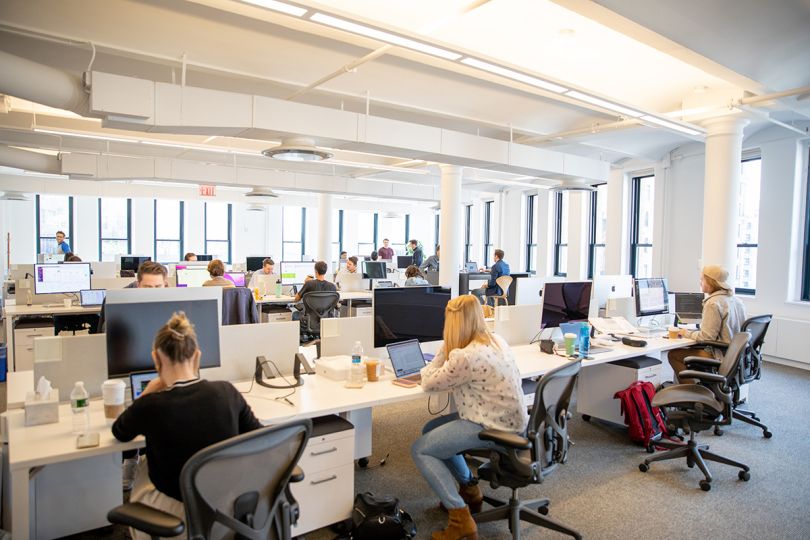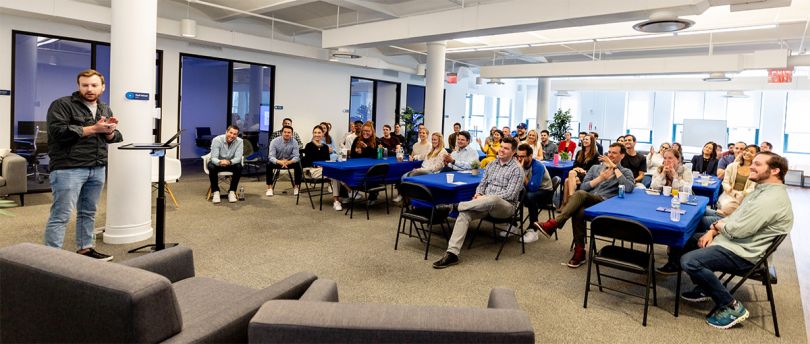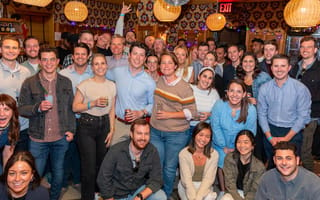A couple of months ago, geofencing platform Radar held a virtual trivia game show that brought out a little friendly competition in its staff — and also put their inherently supportive nature on display.
CEO and co-founder Nick Patrick left the event floored by his team’s flair for facts. “We concluded that a few folks on the team need to go on Jeopardy!,” he said, adding that he’s an avid Jeopardy! watcher himself.
The event provided the perfect opportunity for new hires to meet tenured employees, and vice versa. “People were really excited to see some new faces they hadn’t met before and mix and mingle with those who might not be on their direct teams,” said VP of People Lisa Sholkin.
Beyond their trivia knowledge, Radar’s ambitious culture feeds into what makes the company category-defining, according to Sholkin. “Everyone we hire has a high standard of excellence for themselves and what they produce for our customers,” she said.
So what exactly makes a company category-defining?
“There are a lot of great companies out there,” Patrick said. “Stripe defines the payment space, Twilio defines the communication space and we want Radar to define the location space. That’s a tall task.”
In order to see to fulfilling this goal, Patrick and Sholkin tap into one of the company’s values: Raise the bar. What this looks like in practice is hiring talented individuals who are ready for both autonomy and responsibility. “I always tell candidates my hope is that Radar is the most challenging and rewarding job they ever have,” Patrick said. “We want this to be a place where folks can come and do the best work of their careers.”
The geofencing platform’s team is bridging the gap between digital and physical experiences not only in their work, but also in how they connect as a hybrid team — and the virtual game show is just one example of many. Because of their distributed status, meeting both in person and virtually when possible is a must, especially as their workforce continues to grow.
Having doubled their headcount in 2021, Radar’s team currently sits at around 60 people and plans to grow twofold again this year. With such impressive growth, the need for human connection grows in equal measure. “We work really hard,” Sholkin said, “and I’m a firm believer in providing some lighthearted activities to balance out the challenging work we do.”

What is Radar’s mission, and how do you go about fulfilling it in your day to day work?
Patrick: Radar’s mission is to connect the digital and physical worlds. We’re in the business of helping companies build great location-based app experiences. We talk a lot about the Amazon or Uber effect and how consumers have really high expectations. They are used to ordering a package on Amazon and having it show up on their doorstep the next day or hailing a ride on Uber and seeing the driver coming to pick them up.
We have seen many interesting use cases and habits accelerate after Covid-19, and we’re finding a lot of leading apps are investing in things like curbside pickup, delivery tracking, contactless check in and contactless payments — all of which have a location component that needs to be done well. They require you to bridge a digital app experience with location context and awareness in the physical world. At the end of the day, we offer developer tools, software development kits and application programming interfaces to help companies deliver better and faster locational experiences.
Our vision is location infrastructure for every product and service, and when we say ‘for every product and service,’ we mean it.”
What makes Radar’s platform different compared to others on the market?
Patrick: We’re building the most developer-friendly location platform. Whether you’re a large enterprise or an individual developer working on a side project, we want Radar’s tools to be really easy to pick up and implement. Radar is also the most privacy-friendly location platform. We’re a SaaS company, and we process data on behalf of our customers, but we don’t sell or share that data with any third parties.
How is Radar improving the customer experience and bridging the gap between the physical and digital?
Patrick: Many restaurant and retail apps don’t really understand where we are in the physical world. When I’m using a restaurant app, I probably want to see different features depending on where I am. If I’m at the restaurant, maybe I want to see my order information for curbside pickup. If I’m at home, maybe I want to place an order or look at a store locator. Radar is a mediating layer that helps these apps have location awareness and show folks the right content, messaging and features at the right place and right time.
People are talking a lot about the metaverse; there’s a dystopian future where we strap a pair of virtual reality goggles to our faces, and we live completely in the digital world. It’s good for folks to have great digital experiences, but it’s also important for them to go out into the physical world and connect with the people, places and things around them, especially as Covid-19 subsides. I’d like to think Radar can play a small role in facilitating that.
What will your recent Series C funding allow the company to do in terms of product and growth?
Patrick: Our top priority is continuing to scale our team and make our platform better. When it comes to scaling, we’ve made a ton of leadership hires recently, including Lisa as VP of people. In terms of making the product better, a good analogy is: We have LEGO blocks and also LEGO sets. As an individual developer, you may want to take a few of our LEGO blocks off the shelf and build a location-based experience. If you’re an enterprise in a particular industry, you might ask, “What’s the LEGO set for my use case? Can you help me build it?” We’re investing in both a set of building blocks that comprise our platform, and also solutions for different industries.
Looking ahead, where do you see the Radar’s growth path going from here?
Patrick: Our vision is location infrastructure for every product and service, and when we say “for every product and service,” we mean it. Today we work with leading restaurant brands and retailers, and that’s been a big focus of ours. But we’ve started to see interest from other verticals as well — think sports and entertainment apps, delivery and fleet tracking, travel. Over the next six to 12 months, we’re going to lean into this location infrastructure vision and start to expand outside the core verticals we service today.
I always operate from the standpoint of thinking of employees as my customers.”
What is the employee experience like at Radar, and how are you adapting it to support the growing team?
Sholkin: We operate in a hybrid environment like most companies these days; about 50 percent of our staff are based here in the New York area and the remaining 50 percent are across the continental U.S. We meet quarterly as a company in New York to foster community team building, talk about our goals for the coming quarter and look back at our prior goals.
As we continue to scale, gauging employee feedback will be critical to how we build the company moving forward. I always operate from the standpoint of thinking of employees as my customers. In the same way that we get Net Promoter Scores from customers, internally we ensure that we’re solving the right problems and that the solutions we have in place are effective and meeting our employee needs.
We will also continue to evaluate the technology platforms and experiences that can provide connectivity for our employees both here in New York and across the country. People have Zoom fatigue, so we want to make sure we have a good cadence and that we’re not overwhelming anyone with virtual activities.
What are some notable employee experiences you’ve recently held?
Sholkin: We do a monthly happy hour on the first Tuesday of every month. We have also gone bowling in the past, which was a big success. Our other co-founder, Coby Berman, is a big fan of tennis, so I believe the U.S. Open has been attended. We’ll continue to bake in experiences that aren’t just happy hours — like going to Mets and Yankees games — to ensure that we’re catering to all different interests.
From a people perspective, what sets Radar apart in the location category?
Sholkin: ‘Humble’ is one of the words I often use to describe our employee population. Given how talented people are here, they could be far more boastful and prideful about their abilities, but they remain focused on our business goals and solving tough problems. We’re also empathetic, which is really important. We want to encourage our staff to be supportive of one another in their lives outside of work too. A number of employees have had some big personal milestones recently, and you can sense the excitement from everyone here when someone becomes a new parent, for example — everyone wants to be involved in their journey.
Patrick: Radar does a good job of striking a balance between being a product- and sales-led company. We have engineers and product managers who deeply understand our customers and have respect for our enterprise sales and customer success teams. On the flip side, we have enterprise account executives and customer success managers who deeply understand our technology and products. We want to hire engineers who understand the broader business and market opportunity in front of us, and we want to hire account executives and customer success managers who understand the power of our tech and developer tools.
We want this to be a place where folks can come and do the best work of their careers.”

How do you support your teams in producing high-quality work while also enabling their professional career growth?
Sholkin: What’s critical is ensuring our onboarding process is very streamlined to set any new hire up for long-term success. We’re about to roll out a program where we assign each new hire with a buddy to further help them make connections within the company. We are also continuing to look at how we can best build out learning and development opportunities for staff. One area we will likely focus on in the next quarter or two is new manager development and making sure that all of our newer managers are equipped to help lead their teams forward.
What kind of impact can new hires expect to make in their first few months on the job?
Patrick: We’re at a fun inflection point where we have a really solid foundation to build on. We work with leading brands in different verticals, but we’re just getting started. A company value of ours is “raise the bar,” and something we’ve been thinking about is how to hire bar-raisers and screen for them during the interview process. I tell every new hire that joins the onboarding session, “It’s awesome to get a fresh perspective, and you’re going to spot things we could be doing better.” There’s an opportunity to level up and raise the bar from a team process perspective. We’re looking for folks who are drivers, not passengers, and are excited to roll up their sleeves and make a big impact.







